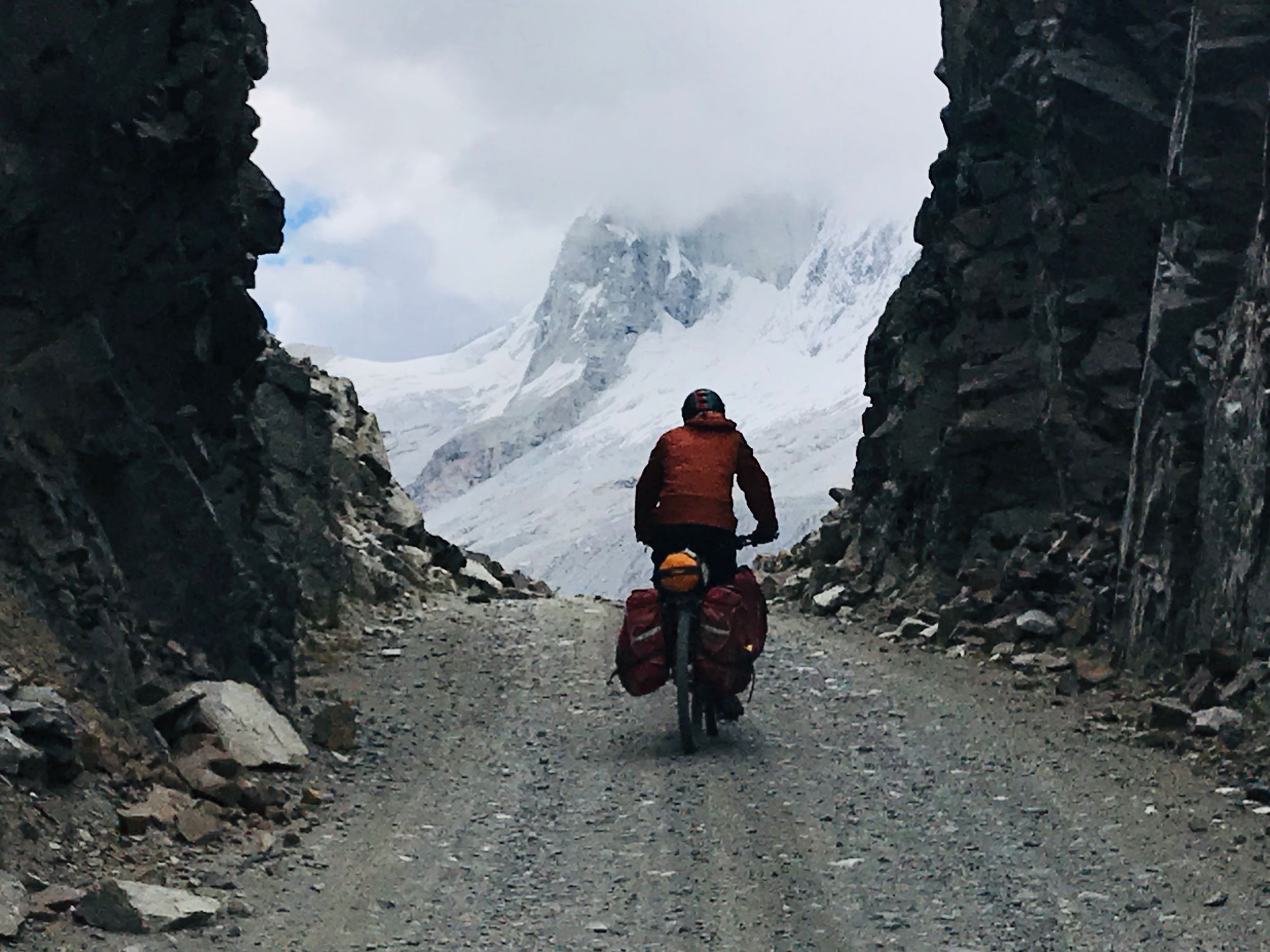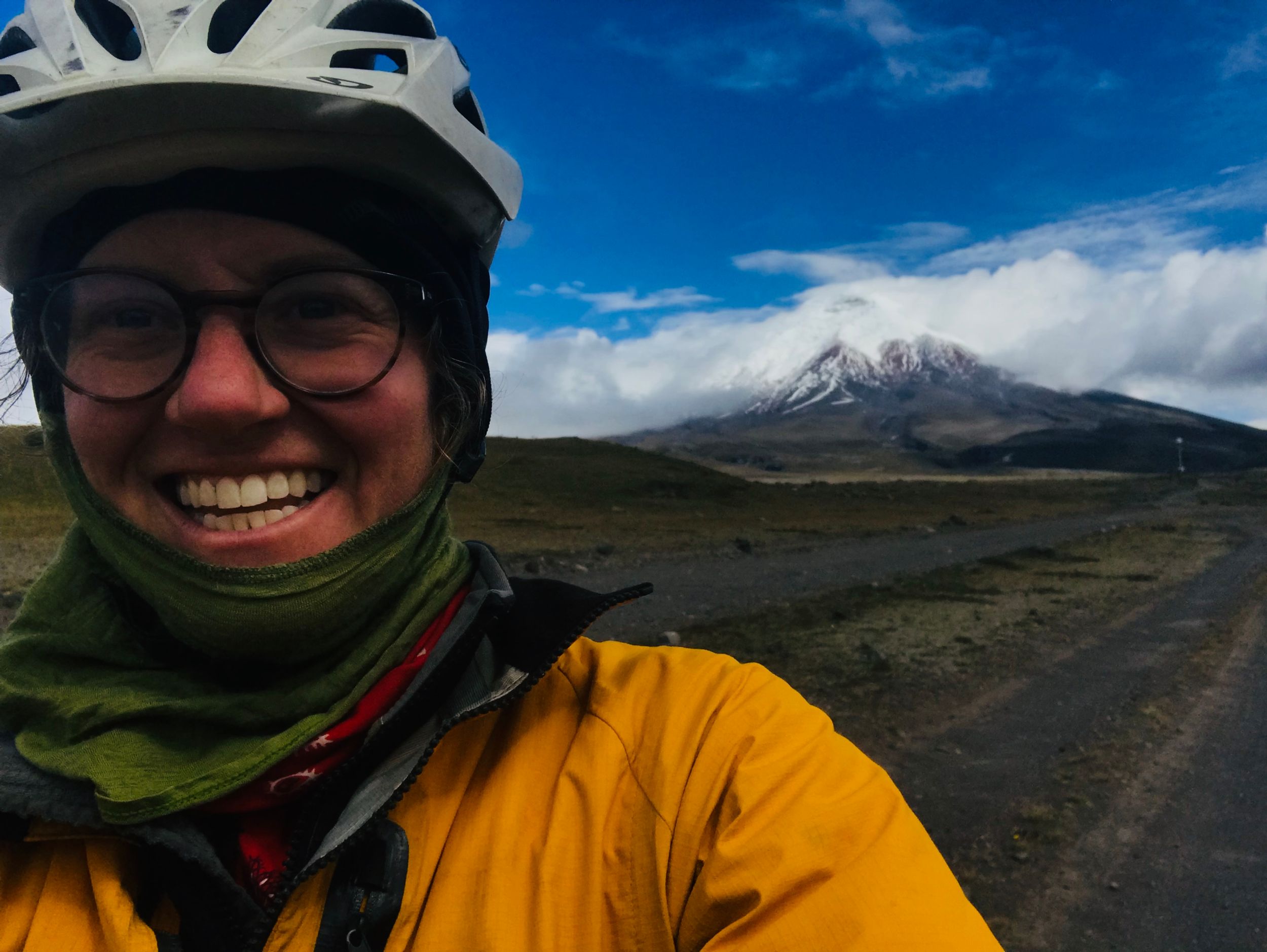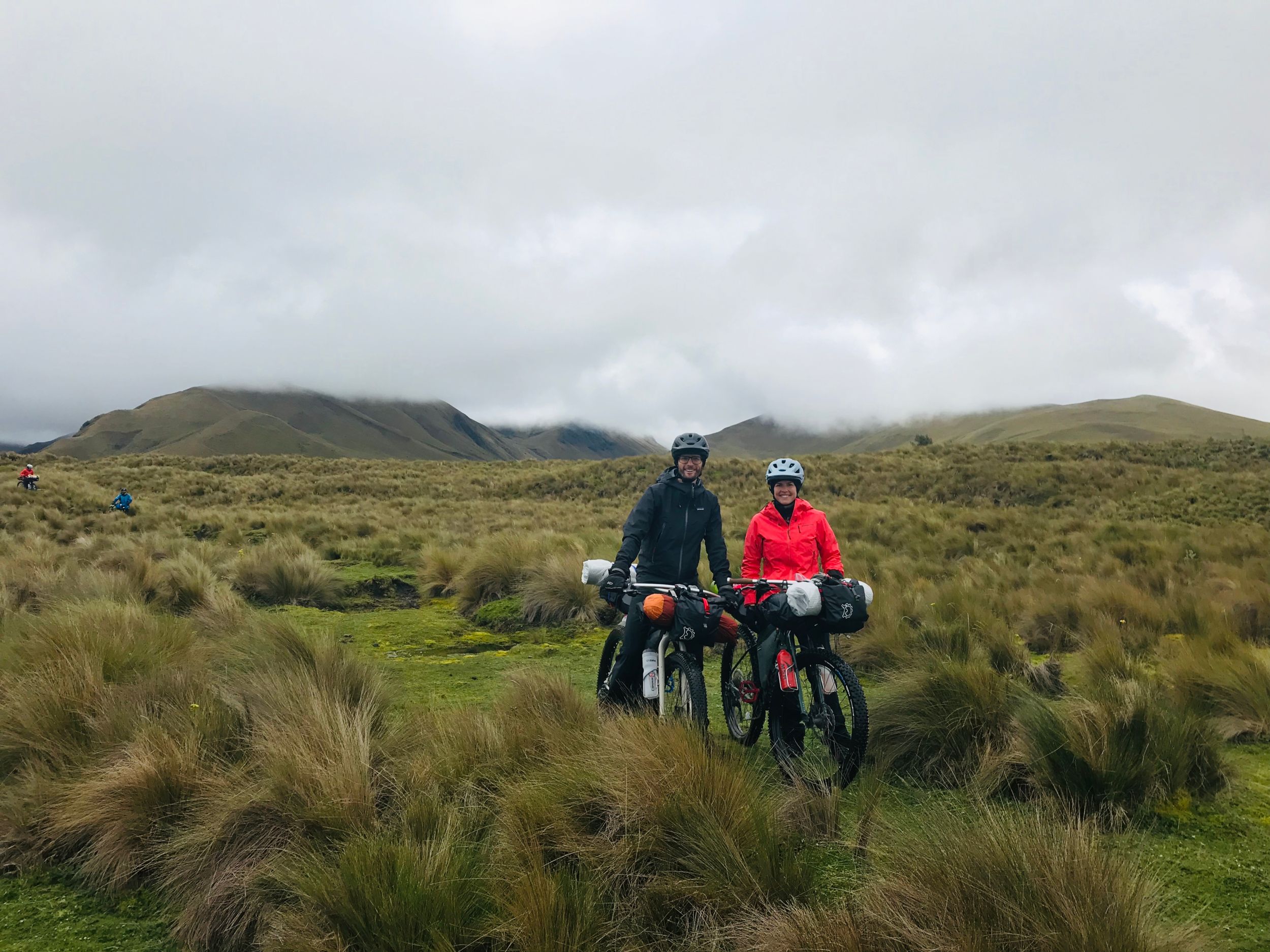Epic Planning
My boss’s thick white mustache twitched nervously under fluorescent lights in the tiny office. Outside, the stars still shone bright in a navy blue sky of frozen predawn. I told him I was quitting after two years with the company, to bicycle around the world. His eyes widened. He was known for being very dedicated, and worked for the same timber company for 40 years. Sweat emanated from my armpits on that frigid December day, and I was sure he would call me crazy and yell at me to get out of his office. Instead, he shocked me by saying, “Wow, that sounds wonderful. You know, you should do this now, while you’re young, don’t wait to retire like me. Send us a postcard.”
Everyone is capable of going on an epic adventure. I am neither brave nor strong, yet here I am, having traveled through 15 countries and many regions in the U.S. on various trips. I am just a normal person. I still get scared sleeping in my tent alone, and have embarrassingly little upper body strength. You do not need anything special to embark on an epic adventure, just the desire and drive to do so.
People often tell me that they want to do a big bike tour, but they do not have enough time. Or enough money. Or they have children. Or their significant other/spouse does not ride bikes. Or they can’t leave their jobs. Or they’re too old. But! There is always a way. People bike tour with kids, or follow animal migrations, travel on a shoestring, or take envelope-pushing weekend trips in order to meet other obligations.

I am about to re-embark on a Round-The-World bicycle tour that I began in 2019. After 14 months on the road, a pandemic-induced disruption has kept me and so many others at home since March 2020. ("COVID Cutoff: An Unexpected Hiatus." Adventure Cyclist Magazine, June 2020). It is finally time to start again. I’ll be gone for another two to three years. Despite being a planner, there have been many sleepless nights, the hamsters of my mind running on wheels of endless to-do lists. There are important things that I’ve somehow forgotten to do (get new tires), and things that are completely arbitrary (repainting the bathroom). But just like everything else in life, we can prioritize and break it all down into manageable chunks. I remind myself of this with deep breaths at all hours of the day and night. But how did I get to this enviable spot, in the final stages of planning and departing to travel for so long? More importantly, how can YOU find a way to plan your own epic bicycle adventure?
Time
Time is the base of our planning pyramid, because it defines where we go and how we go. It is also a precious commodity we can never get back, and it is slipping through our hands every day. First, figure out when you can take time off work, and how much time. Don’t pick a place and then say, “I can never bike tour in Canada because I only have time off in the winter. Poor me!” Use your time off to guide the rest of your decisions. Look at your chunk of time – hopefully months – and guard it. Write it in your calendar. Talk to your boss about it.
Conversely, decide if you want to take a pause in your career. This worked out well for me, and sometimes this is easier to do in the beginning of your career than later. People also switch companies all the time, so if you think of it as a pause between jobs, it is much less daunting. Many companies will see your diverse travel experiences as a plus, and you can resume your career when you return. If you are older, maybe an early retirement is in the cards. Ask yourself, “Do I want to adventure or not?” Take the necessary steps in life to make it happen.
If you have children, how long can you be apart from them? Or can you take them with you? How long will your significant other let you leave and still welcome you back? The more time you have the better, since we are indeed talking big adventures here!

Once you know how much time you have and what part of the year it falls in, then look at the seasons. Is it summer or winter in the northern hemisphere? Unless you’re a masochist, time off in winter might rule out much of the U.S. But years ago, a friend and I worked in bike shops and couldn’t take time off until October, so we rode the Southern Tier Bicycle Route and had a ball. It snowed on us in Arizona, and it was beautiful. Bike touring in the southern states of the U.S., Central America, Baja, and Mexico are also options for the winter. If you’re up for off-road cycling, bikepacking.com contains a plethora of resources for routes all over the globe. Go BIG! It’s never the perfect time, so just go. If you have ample funds for a plane ticket, think about the Southern Hemisphere. You can also sign up for a newsletters that notifies you of cheap flights (Pomelo, Scott’s).
It is surprising how quickly you can narrow your scope when you simply ask, “When can I be gone for the most amount of time?” then, “Where can I go?”, and finally asking “where do I want to go?” Think about your other parameters thirdly. Do you want desolate dirt roads? Museums? Good food? Good art? Jungles or deserts?
If you don’t have unlimited time, decide if you want to cover a lot of ground quickly, weaving in some type 2 fun, or if you want to relax and pedal leisurely. That will help you narrow down the route and location. What can you do in 2-3 weeks?
Circumnavigate a peninsula in Costa Rica? Bike as fast as possible along the Northern Tier and take a bus home? Choose a reasonable amount of miles to cover, and have a bailout plan (bus, train, hitch hike) in case you can’t make it due to some unforeseeable delay (rainstorm, illness, one million flat tires).
Money
For many of us, our budget will act like a seesaw with our time. If money is your limiting factor, figure out how many weeks or months or years you can stretch your funds. This will depend on where you are going, and what level of discomfort you are willing to endure. I prefer to sleep outside and eat beans and rice (or whatever the cheapest thing to eat is where I am), in order to be gone as long as possible. But if you want to sleep in hotels every night, your money will not stretch as far. Money can inform your destination choice; some places are cheaper (Colombia, Guatemala) than others (Switzerland, Norway).

If you have indeed quit your job and have somewhat unlimited time, you are really able to fling yourself out there. Congratulations. Plane tickets will obviously cut into your budget, but this new locale may have noodles for $1, so things might balance out. A lot of solid adventures can be had with less than what we spend on housing each month, or every couple of months – around $1500 can get you rather far. There are certainly people out there who are better qualified to advise you on how to strategically save money, and probably have spreadsheets to make things more complicated than they need to be. But my advice is: pare down, and don’t buy things. Every time I decide to not buy something I want (a concert ticket, a fancy coffee, a cool dress), I consciously think about how long that money will last me on a trip, especially in another country with a favorable exchange rate. Do I want the dress or do I want the adventure? I want the adventure. And if you’ve read this far, you do too.
Loved Ones
If your limiting factor is other people (kids and partners)
Kids
If you’re going solo, talk with whoever is taking care of your kids while you’re gone, and come to an agreement on the number of days you’ll be gone. While cycling in Patagonia, I met a French woman who sent videos or skyped with her 8-yr-old daughter every day. She said they were quite close and her daughter loved following the adventure. You don’t have to be unavailable just because you’re not physically there. A touring musician I met said she could only be gone for two weeks, or else she missed the smell of her two-year-old, and felt she missed too much of his growth. There is an old adage that says, “Kids don’t listen to what you say, but they watch everything you do.” I believe that by going on big adventures, we are empowering our kids to do the same.
I have been overwhelmingly impressed by stories of folks taking their kids on trips. By showing their kids a different way of life, they are opening them up to so much. The group might pedal 20 miles a day then play frisbee for the afternoon. They modify miles and itineraries to fit the kids’ needs, while maintaining the status of Epic Adventure for everyone. Some tote toddlers in trailers on Rails-to-Trails routes, while others take kids on tandems. There are plenty of resources to help plan a trip involving kiddos: from Adventure Cyclist, from Outside Magazine, and from REI. There are also many blogs about traveling with kids.

Spouses/Significant Others
This seems to mostly fall into three categories, and Alastair Humphreys’ book, Grand Adventures, helped me dissect these situations before my own departure(s). Hats off to Humphreys, who has given many of us, including myself, the extra push to chase our dreams, especially the big ones.
Situation 1: They can and want to go with you.
Hooray! Make sure they know what to expect, so there’s no tears in the rain.
- Plan accordingly, and discuss time, money, and acceptable levels of comfort/discomfort to make sure you’re on the same page. The longer the trip, the more important planning together is.
- Travel can be stressful on relationships, so make sure your communication is good and both of you are equally contributing to the trip, so one does not feel like they are dragging the other along, or vice versa. Be flexible and open to compromise. Discuss what might go wrong, and how you will deal with it.
- A little alone time can help maintain the relationship (and sanity for my fellow introverts). Bring all the patience you can muster, because you will get annoyed with each other at some point, and that is okay. You might want to do different things when you reach a town, and that could be a good time to give each other space.
Situation 2: They can’t go with you, but are supportive.
Also hooray, with the most honeymoon-like, cuddly reunion. This was the case with me and my husband. I left before our first wedding anniversary, and he was my number one cheerleader. In fact, he still is!
- Plan how you will communicate while you’re gone, and talk about what fears or worries they might have. Try your best to alleviate these concerns.
- Test out your chosen method of communication (SPOT device, Whatsapp, etc.).
- Give your family your tentative itinerary, and show them the other people who are doing this ‘crazy’ thing. When I left for my round-the-world trip, I set up an Instagram account for my mom and inundated her and my sister with posts and accounts of other women traveling solo. It worked! They no longer think I am completely nuts.
Situation 3: They don’t want to go, and they don’t want you to go.
Ask why they don’t want you to go, and see if you can compromise on these aspects. Is it the time, the money, the chores or childcare they will be left to tackle solo? Are you going with an attractive travel companion? Do they think it is too dangerous? Is it too dangerous? See if you can talk it out and alleviate their concerns. Can you hire help for children or housework? Can you get a friend or relative to help? Maybe your partner is saying now is not the time to go, especially if you have small children. Keep planning though, because “not now,” is not the same as “not ever.” I planned for seven years for my long tour, mainly because I needed to finish a masters degree then save up money, which took a long time. Hold fast to the dream!
If your partner is worried about the danger, remind them that most of the time, people perceive unknown situations to be much more dangerous than they actually are. Gather evidence and make your case for your location. (If you can’t, that might be a sign you should choose a different place.) When I cycled through Mexico and Central America, I checked in as often as possible with my husband, and stayed in more hotels instead of camping. It wasn’t always what I wanted to do, but it put him at ease, and that was important to me. Sometimes our lives are not only our own, and we need to consider our parents, partners, friends, and kids. These considerations might alter our adventures, but it doesn’t have to end them.
Lists and Plans

Make a massive to-do list on a poster board or butcher paper. Share this with a friend who might have helpful suggestions. Then make a smaller one with the things that actually, really do have to get done before you leave. Prioritize the shorter list. Accept that you will not get everything on the list done, but prioritize what’s necessary. Some important things are type 2 fun (not fun to do, but once on the road, you’ll be glad you did them).
Make all bills/house payments/kids allowances automatic. Streamline your finances so that you can meet your obligations without futzing around with online banking while you’re gone. Have one account responsible for bills, etc. and leave that card at home if you can. This way, if a card gets stolen or hacked while you’re traveling, you’ll have less to reset. Divide your traveling spending money into a few accounts, and set up some automatic transfers. This might sound like a headache now, but it’s much less work than dealing with a replacement card somewhere remote where you don’t speak the language. Use one main card while you’re gone, and hide 1-2 others in hidden pannier pockets.
Get your gear list together. This can be very fun! If you need to buy gear, look at eBay and Craigslist often, because new things pop up every day. I have found a good amount of quality, barely-used things through these sites. This relates to the money part – be thrifty. Don’t postpone your trip because you spent too much on gear. It’s better to go with what you already have than not go at all.
Nuts and Bolts
Calculate mileage, days needed, and rest days. Try not to be overly ambitious, and remember to enjoy yourself. If you can, don’t worry about your return trip. Just go. If you really must be back by a certain date, have a back up plan in case things go awry, and discuss this backup plan with loved ones.
Get a book or several from the library or bookstore, and read about the places you’ll be going. Learn about the culture and the food. Don’t just read the news, because that really should be titled, “bad stuff that happened today.” Instead, talk to people who have been there before, especially on bikes. Look at other people’s routes and do the same route, or alter it and make your own. Study maps, because it is quite fun. Ask questions, and reach out to friends of friends who might live there.
Finally, Pack your bags, and go now. Go far. Do not wait for something to happen to you, or for the ‘right time’ to magically appear. Let 2023 be the year you grab life by the horns and hop on. Then come back and tell us all about it.

